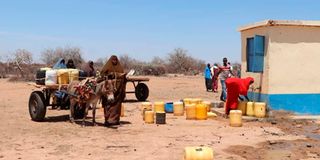Solar comes to the aid of drought-ravaged north

Isnina Abass, a resident of Ahmed Tukalo Village pulls a cart close to a water point in her village in Garissa County. As drought ravaged the area, residents in her village can breathe a sigh of relief after a solar-powered water project was launched to supply them with water.
What you need to know:
- Unicef and devolved governments in northern Kenya partner to drill boreholes as thousands of families face hunger due to the ongoing drought in the Horn of Africa. With fuel shortages experienced in Kenya and many other parts of the world, solar energy comes to the rescue of thousand. Villages have turned to solar pumps to get the much-needed water for themselves and their animals.
For two years, 32 year-old Isnina Abass – a resident of Ahmed Tukalo village in Garissa county – has not seen rain.
As a norm in Lagdera constituency, women use donkeys to get water or roll jerrycans on the ground all the way home.
The distance is usually 10 kilometres or more.
A drive to Ahmed Tukalo, about 200 kilometres from Garissa town, reveals the effects of the ongoing drought. Tens of decomposing animal carcasses litter the dry fields.
“Getting food and water is difficult. Only the toughest animals have survived,” Ms Abass says.
Some of her neighbours have crossed into Somalia with their cattle, sheep, camels, goats and donkeys. The Daily Nation team accompanied Ms Abass to a borehole in her village. The water is pumped in tanks that have taps.
Just months ago, Ms Abass would not have gone to the borehole for water. The tank would had no water as there was no fuel for the pumping generator.
She and the rest of the women in the village would make the 10-kilometre journey to the waterpoint in Gangubane.
“We have had a rough time. A 20-litre container of water here costs Sh5. We had to find alternative sources of water. Locals were informed that transporting petrol from Garissa was also a challenge,” she says.
Ms Abass and many others now have a reason to smile following the installation of a solar-powered pump in her village. Even without petrol, clean water is readily available to all.
Ahmed Tukalo Water Project (ATWP) is a climate-friendly partnership between the Garissa devolved government and Unicef. The tank uses solar power to produce energy for the pump.
According Garissa County Water Services Chief Officer Ahmed Abdinoor, the region has borne the full brunt of global warming, having missed four rainy seasons.
“This has had a huge impact on residents, with many being pastoralists. The animal population has fallen by 70 per cent,” Mr Abdinoor said.
“Even though northern Kenya is prone to droughts, we have never missed four consecutive rainy seasons.”
The county government official adds that the next rainy season should be in November, meaning the situation would get worse.
According to the Inter-Governmental Authority on Development (Igad), at least 29 million people in eastern Africa face high levels of hunger due to the ongoing drought.
Mr Abdinoor says to help the region remain climate-resilient, the county government has come up with meaningful projects, including drilling boreholes in villages.
“We have put in place a drought response team that checks if waterpoints are working. We also repair boreholes,” he says.
ATWP chairman Siyad Haji says his responsibilities include ensuring the pump is working and the area is secure.
In Sopel, Turkana county, the waterpan is the meeting point. Locals arrive with their animals at the point as early as 9am.
A schedule ensures every family gets a chance to water its animals.
In regions like Turkana, the threat of climate change hovers around every homestead. Most seasonal rives and wells are dry. So are trees.
According to a 2021 report by the National Drought Management Authority (NDMA), some 80 per cent of water sources have already dried up because of the underperformance of 2020 and 2021 rains.
Water executive Vincent Parlor says Turkana has suffered the ravages of global warming.
To help solve the water crisis and ensure families have enough to drink, Unicef and the devolved government through funding from Korea International Cooperation Agency mainstreamed climate change in the Water, Sanitation and Hygiene (WASH) programme response.
“The United Nations agency has partnered with the county government of Turkana in strengthening community resilience to climate change through improved water supply and in an effort to ensure 98,000 people have access to safe water by the end of this year,” says Jackson Mutia, the WASH Specialist Unicef Kenya in Lodwar.
Oversee watering points
More than 30 per cent of Turkana county residents have no access to safe drinking water.”
Apart from the borehole in Sopel serving animals, it is also a source of drinking water for the community, hospitals, schools and other institutions nearby.
To further mitigate the impact of climate change, solar energy is used in the water supply system.
“Solar power is clean, affordable and easy to maintain. Turkana and neighbouring regions are arid and hot and there is enough energy to pump water,” Mr Mutia says.
“We also have storage tanks for rainy water. This usually comes in handy when the water table reduces.”
Unicef is also working with county government authorities to train a committee to oversee the watering points and other issues such as contingency planning.
“Under the partnership, we have sunk 72 boreholes and equipped 53 of them. That means more than 100, 000 residents in these areas have access to safe drinking water for themselves and the animals,” Mr Mutia adds.
The WASH specialist advises leaders in Turkana and other dry counties to come up with solutions that will end the water and food crises.
“These include drilling boreholes, making sand dams and adopting solar panels for the water supply system,” he says.






